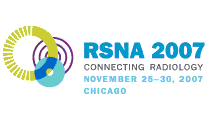
Abstract Archives of the RSNA, 2007
SSQ04-02
MR Enterography with Polyethylene Glycol Solution as Oral Contrast Agent: Evaluation of Crohn’s Disease Activity
Scientific Papers
Presented on November 29, 2007
Presented as part of SSQ04: Gastrointestinal (Crohn's Disease: CT/MR)
Francesca Invernizzi MD, Presenter: Nothing to Disclose
Sandro Sironi MD, Abstract Co-Author: Nothing to Disclose
Davide Ippolito MD, Abstract Co-Author: Nothing to Disclose
Maria Rita Panelli MD, Abstract Co-Author: Nothing to Disclose
Ferruccio Fazio MD, Abstract Co-Author: Nothing to Disclose
To evaluate the role of MR enterography(MRE) after oral administration of isotonic solution in monitoring Crohn’s disease(CD) activity.
Thirty-five consecutive patients with histopatologically confirmed Crohn’s disease and suspected relapse based on clinical data and Crohn’s Disease Activity Index(CDAI) underwent MRE examination after drinking 1,5-2 litres of Polyethylene Glycol(PEG)solution during 50 minutes. Before the exam Buscopan 20 mg/ml was administered intravenously. MRE examinations were performed at 1,5 T by using a phased array sense body coil. The MRE protocol included axial and coronal T1 weighted images; sSShT2, sBTFE and gadolinium enhanced THRIVE sequences. Intestinal and extraintestinal manifestations of disease were evaluated by two radiologists, indipendently. To evaluate loops distention they divided small bowel into 4 parts(duodenum,proximal jejunum,distal jejunum,ileum) and gave a 3-points score(1 fair;2 good;3 excellent).
Oral solution was well tolerated by the patients ; no serious complication was noted(only mild diarhea in 3 patients).An excellent or good distension of duodenum was obtained in 18 patients(45%);of proximal jejunum in 26 patients(65%),of distal jejunum in 30 patients(75%) and of ileum in 36 patients(90%).MR enterography revealed relapse of the disease in 27 patients(77%);of these MRE revealed wall bowel enhancement in 20 patients(74%),10 had a layered enhancement(50%);comb sign in 8 patients(29%);fibrofatty proliferation in 5(20%),enhanced mesenteric lymph nodes in 10(37%).Extraintestinal manifestations(fistulas and sclerosing cholangitis) were detected in 8 patients(29%).During active phase we observed a layered pattern of enhancement at the level of the pathological wall, related to a marked enhancement of the internal layer(mucosa and submucosa), instead during inactive phase we observed an homogeneus pattern of wall enhancement.
MRE with PEG solution permits a good evaluation of small bowel loops, allowing assessment of the activity of CD.
MR enterography is a radiation free, feasible and valuable imaging tool to monitor the Crohn’s disease activity and the effectivness of the treatment.
Invernizzi, F,
Sironi, S,
Ippolito, D,
Panelli, M,
Fazio, F,
MR Enterography with Polyethylene Glycol Solution as Oral Contrast Agent: Evaluation of Crohn’s Disease Activity. Radiological Society of North America 2007 Scientific Assembly and Annual Meeting, November 25 - November 30, 2007 ,Chicago IL.
http://archive.rsna.org/2007/5009320.html

